Research Article - (2022) Volume 10, Issue 11
Incidence of Patients Seeking Retreatment of Malocclusion Reporting to the Institution Over 1 Year Period
Abigail Ranasinghe* and Harish Babu
*Correspondence: Dr. Abigail Ranasinghe, Department of Orthodontics, Saveetha Dental College and Hospitals, Saveetha Institute of Medical and Technical Sciences, Saveetha University, Tamil Nadu, Chennai, India, Email:
Abstract
Introduction: Orthodontic treatment not only results in better aesthetics, but it also plays a role in maintaining oral hygiene, managing occlusion. A growing number of adult patients are seeking orthodontic treatment. Decisions for retreatment might be related to the fact that the results of the initial orthodontic treatment in adolescence were not satisfactory or ideal. The aim of this study is to determine the incidence of patients seeking retreatment of malocclusion.
Materials and methods: This study is a retrospective observational study conducted in a university hospital in Chennai. This study was carried out between the months of November 2020 March 2021. Data of patients who were given removable appliances were included in the study sample. This was followed by excel tabulation. Data was analysed using SPSS Software. The association of study variables was calculated using Chi Square test.
Results: The most common age group associated with removable appliance therapy was found to be the age group between 21-30 (62.1%). Majority of the patients who reported were females(53.8%) when compared to males. 50.7% of the study population had retreatment due relapse while 49.3% were new patients.
Conclusion: Patient mentality is an essential factor in the success of an orthodontic treatment since they must be willing to follow the instructions to maintain stability and avoid relapse. The clinician needs to plan an appropriate retention strategy to overcome the relapse potential.
Keywords
Malocclusion, Retreatment, Removable appliance, Relapse
Introduction
Orthodontic treatment and provision of orthodontic care for adults has increased considerably over the past two decades. Orthodontic treatment not only results in better aesthetics, but also plays a role in maintaining oral hygiene, managing occlusion that can result in temporomandibular disorders and conditions like obstructive sleep apnoea due to craniofacial abnormalities causing reduced blood flow [1-3]. Among all patient populations, there is a group who have had previous orthodontic treatment and decided to seek retreatment. It has been shown that the decision to seek orthodontic treatment is based on several factors [4-6]. Decisions for retreatment might be related to the fact that the results of the initial orthodontic treatment in adolescence were not satisfactory or ideal. The reasons behind this may be an unfavourable skeletal growth pattern during and after treatment, insufficient compliance or relapse after treatment resulting in discontinuation thus compromising the initial treatment goals [7,8].
Relapse from orthodontic treatment tends to move back to the original occlusion [9]. Though it doesn't always tend to move back to the original occlusion, it is considered as an unfavourable change far away from corrected malocclusion [10]. Relapse can be caused by orthodontic factors like gingival, periodontal, occlusal factors, soft tissue pressure, limits of dentition and age changes [11]. In case of fixed retention appliances, failure to bond the appliance with the proper adhesives and skipping reviews can affect the quality of treatment [12,13]. Temporary anchorage devices like mini implants are placed to treat impacted teeth. Though the chances of relapse in impacted teeth are considered to be less likely, failure to maintain retention procedures can lead to a minor degree of relapse [14,15]. Decisions for retreatment could also be related to increased self-perception of dental appearance [16,17]. As the incidence of orthodontically treated subjects has increased in the last decade, dental appearance in general has improved. It is likely that what was previously regarded as a minor deviation is today considered a trait which requires further treatment.
Several studies reported a considerable amount of both objective and subjective treatment need in young adults with a previous history of orthodontic treatment [18,19]. Compared with untreated subjects, the treated subjects had an equal amount of [20,21] or even a higher treatment need. However, not all patients with a history of orthodontic treatment seek retreatment. Those who do may have a higher level of self-perception of dental aesthetics, with a good socio economic status, and with or without an objective treatment need. Retainers can be fixed or removable. This study has included a study population that had removable orthodontic treatment either due to relapse or as a new patient.
Materials and Methods
Study design: This study was a retrospective observational study conducted in a university setting located in South India. Approval for the project was obtained from the institutional review board of Saveetha institute of medical and technical sciences, Chennai, India.
Sampling: Data of patients were reviewed and then extracted. All patients who had undergone removable appliance therapy in the given duration of time period were evaluated. Only relevant data was included to minimize sampling bias. Simple random sampling method was carried out. Cross verification of data for error was done by the presence of an additional reviewer. Incomplete data collection was excluded from the study.
Data collection: A single calibrated examiner evaluated the digital case records of patients who reported to Saveetha Dental College from June 2020 March 2021 were reviewed. Patients who needed removable appliance were taken into account.
Statistical analysis: The collected data was tabulated and analysed with a statistical package for social sciences for windows, version 20.0 (SPSS Inc., Vancouver style) and results were obtained. Categorical variables were expressed in frequency and percentage. Chi square test was used to test association between categorical variables. Chi square test were carried out using age, gender and as independent variables and dependent variables. The statistical analysis was done by Pearson chi square test. P value <0.005 was considered statistically significant.
Results and Discussion
The most common age group associated with removable appliance therapy was found to be the age group between 21-30 (62.1%), followed by 10-20 (25.2%), followed by the age group between 31-40 (12.8%) (Figure 1). Majority of the patients were females (53.8%) when compared to males (48.1%) (Figure 2). 50.7% of the study population had retreatment due relapse while 49.3% were new patients (Figure 3).
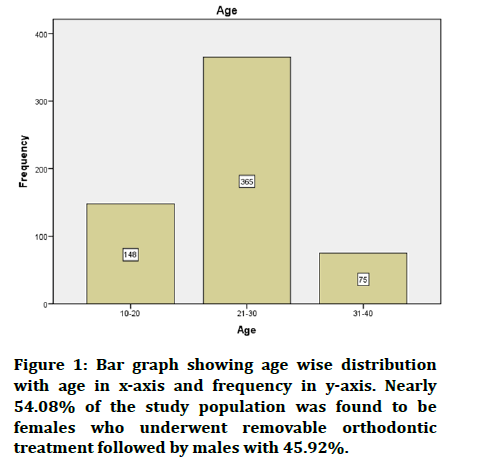
Figure 1: Bar graph showing age wise distribution with age in x-axis and frequency in y-axis. Nearly 54.08% of the study population was found to be females who underwent removable orthodontic treatment followed by males with 45.92%.
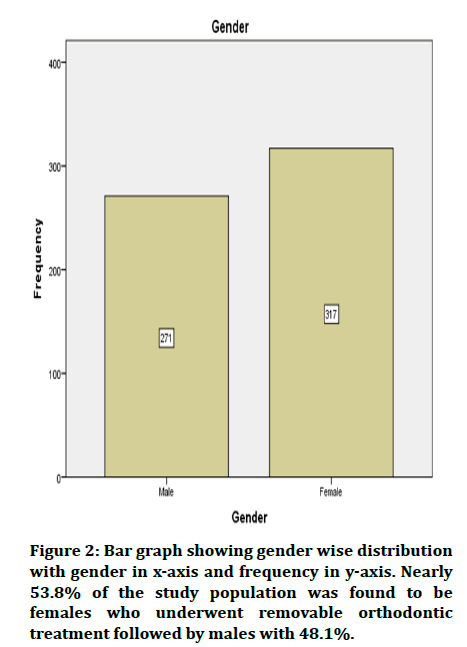
Figure 2: Bar graph showing gender wise distribution with gender in x-axis and frequency in y-axis. Nearly 53.8% of the study population was found to be females who underwent removable orthodontic treatment followed by males with 48.1%.
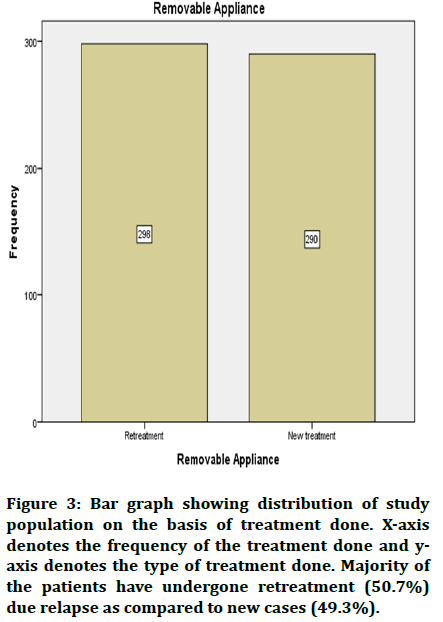
Figure 3: Bar graph showing distribution of study population on the basis of treatment done. X-axis denotes the frequency of the treatment done and yaxis denotes the type of treatment done. Majority of the patients have undergone retreatment (50.7%) due relapse as compared to new cases (49.3%).
In our study the majority of the participants who underwent orthodontic treatment were young adults. It is known that young adults have a more critical appraisal of orthodontic treatment needs than other age groups. In the present sample, a higher percentage of females presented for retreatment than males. This finding is in consensus with previous literature and may be related to the fact that females are more concerned about aesthetics when compared to men [22]. Compromised results due to lack of cooperation from the initial treatment and increased awareness of dental appearance are possible factors for seeking retreatment [23]. In the present study higher percentage of participants who needed removable appliance had already undergone orthodontic treatment. Orthodontic treatment may have raised their perceptions of the dentition [24]. Patients who had undergone previous orthodontic treatment also show greater self-control and dental awareness than those who have not previously been treated.
Patients with a previous treatment history are more likely to be aware of their own teeth and become easily dissatisfied with a developing tooth irregularity or malocclusion, compared with patients who have not had treatment. Moreover, the present results indicate that these patients may also have developed a high perception of facial and profile appearance and are aware of the fact that dental irregularity may result in facial unattractiveness (Figures 1-5).
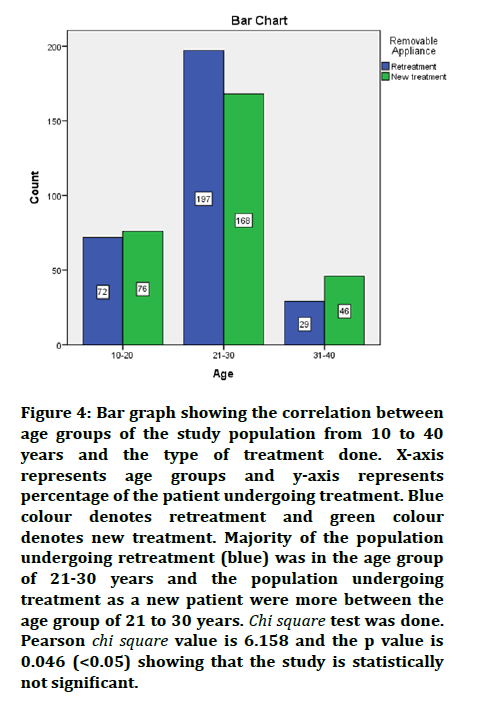
Figure 4: Bar graph showing the correlation between age groups of the study population from 10 to 40 years and the type of treatment done. X-axis represents age groups and y-axis represents percentage of the patient undergoing treatment. Blue colour denotes retreatment and green colour denotes new treatment. Majority of the population undergoing retreatment (blue) was in the age group of 21-30 years and the population undergoing treatment as a new patient were more between the age group of 21 to 30 years. Chi square test was done. Pearson chi square value is 6.158 and the p value is 0.046 (<0.05) showing that the study is statistically not significant.
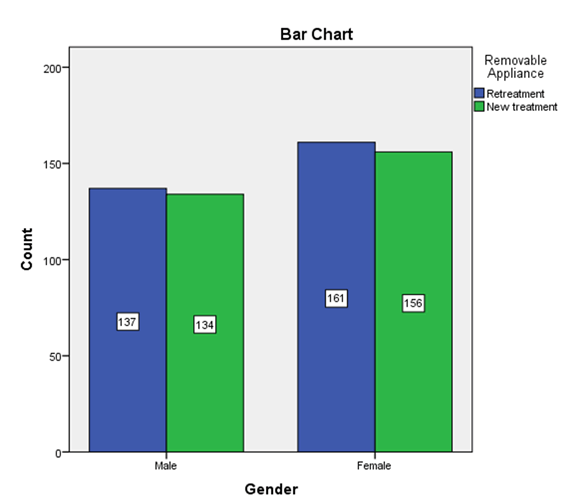
Figure 5: Bar graph showing the association between gender of the study population and the type of the treatment done. X-axis represents the gender and yaxis represents the percentage of patients. Blue colour denotes retreatment and green colour denotes new treatment. Females were more likely to undergo treatment as retreatment (blue) and as well as new treatment (green) as compared to male patients. Chi square test was done, Pearson chi square value 0.003 and the p value 0.955 (>0.05). Hence, statistically not significant.
Conclusion
Patient mentality is an essential factor in the success of an orthodontic treatment since they must be willing to follow the instructions to maintain stability and avoid relapse. The clinician needs to plan an appropriate retention strategy to overcome the relapse potential.
Within the limitations of the study it was found that the majority of the participants of the study population that already underwent orthodontic treatment were willing to accept retreatment after relapse. Majority of the patients that underwent retreatment were females when compared to males. Retreatment after relapse can show adequate result. It is the clinician’s responsibility to give instructions regarding the care of the retainers and provide advice about the timing of retainer review.
References
- Viswanath A, Ramamurthy J, Dinesh SPS, et al. Obstructive sleep apnoea: awakening the hidden truth. Niger J Clin Pract 2015; 18:1–7.
- Felicita AS, Chandrasekar S, Shanthasundari KK. Determination of craniofacial relation among the sub ethnic Indian population: A modified approach (sagittal relation). Indian J Dent Res 2012; 23:305-312.
- Krishnan S, Pandian K, Kumar S. Angular photogrammetric analysis of the soft tissue facial profile of Indian adults. Indian J Dent Res 2018; 137.
- Birkeland K, Boe OE, Wisth PJ. Relationship between occlusion and satisfaction with dental appearance in orthodontically treated and untreated groups. Eur J Orthod 2000; 22:509-518.
- De Muelenaere KR, Coetzee CE, Ackerman A. The treatment need of a group of senior dental students as assessed by the IOTN and PAR indices. SADJ 1998; 53:185-191. [Crossref]
- Fernandes LM, Espeland L, Stenvik A. Patient cantered evaluation of orthodontic care: A longitudinal cohort study of children's and parents’ attitudes. Am J Orthod Dentofacial Orthop 1999; 115:227-232.
- Berg R. Post retention analysis of treatment problems and failures in 264 consecutively treated cases. Eur J Orthod 1979; 1:55-68.
- Myrberg N, Thilander B. Orthodontic need of treatment of Swedish schoolchildren from objective and subjective aspects. Scand J Dent Res 1973; 81:81-84.
- Jain RK, Kumar SP, Manjula WS. Comparison of intrusion effects on maxillary incisors among mini implant anchorage, j hook headgear and utility arch. J Clin Diagn Res 2014; 8:ZC21–ZC24.
- Felicita AS. Quantification of intrusive/retraction force and moment generated during en masse retraction of maxillary anterior teeth using mini implants: A conceptual approach. Dent Press J Orthod 2017; 22:47-55.
- Littlewood SJ, Russell JS, James Spencer R. Why do orthodontic cases relapse? Orthod Update 2009; 38–44.
- Kumar KRR, Shanta Sundari KK, Venkatesan A, et al. Depth of resin penetration into enamel with 3 types of enamel conditioning methods: A confocal microscopic study. Am J Orthod Dentofacial Orthop 2011; 479–485.
- Samantha C, et al. Comparative evaluation of two BIS-GMA based orthodontic bonding adhesives a randomized clinical trial. J Clin Diagn Res 2017; 11:ZC40–ZC44.
- Felicita AS. Orthodontic management of a dilacerated central incisor and partially impacted canine with unilateral extraction a case report. Saudi Dent J 2017; 29:185-193.
- Felicita AS, Sumathi Felicita A. Orthodontic extrusion of ELLIS class VIII fracture of maxillary lateral incisor the sling shot method. Saudi Dent J 2018; 265–269.
- Gosney MB. An investigation into some of the factors influencing the desire for orthodontic treatment. Br J Orthod 1986; 13:87-94.
- Espeland LV, Stenvik A. Perception of personal dental appearance in young adults: relationship between occlusion, awareness, and satisfaction. Am J Orthod Dentofacial Orthop 1991; 100:234-241.
- Lagerstrom L, Stenvik A, Espeland L, et al. Outcome of a scheme for orthodontic care: A comparison of untreated and treated 19-year-olds. Swed Dent J 2000; 24:49-57.
- Kerosuo H, Kerosuo E, Niemi M, et al. The need for treatment and satisfaction with dental appearance among young Finnish adults with and without a history of orthodontic treatment. J Orofac Orthop 2000; 61:330-340.
- Bergstrom K, Halling A, Wilde B. Orthodontic care from the patient’s perspective: perceptions of 27-year-olds. Eur J Orthod 1998; 20:319-329.
- Pietila T, Pietila I. Dental appearance and orthodontic services assessed by 15-16-year-old adolescents in eastern Finland. Community Dent Health 1996; 13:139-144. [Crossref]
- Stenvik A, Espeland L, Linge BO, et al. Lay attitudes to dental appearance and need for orthodontic treatment. Eur J Orthod 1997; 19:271-277.
- Sahm G, Bartsch A, Witt E. Micro electronic monitoring of functional appliance wear. Eur J Orthod 1990; 12:297-301.
- Tuominen ML, Tuominen RJ, Nystrom ME. Subjective orthodontic treatment need and perceived dental appearance among young Finnish adults with and without previous orthodontic treatment. Community Dent Health 1994; 11:29-33.
Author Info
Abigail Ranasinghe* and Harish Babu
Department of Orthodontics, Saveetha Dental College and Hospitals, Saveetha Institute of Medical and Technical Sciences, Saveetha University, Tamil Nadu, Chennai, IndiaCitation: Abigail Ranasinghe, Harish Babu, Incidence of Patients Seeking Retreatment of Malocclusion Reporting to the Institution Over 1 Year Period, J Res Med Dent Sci, 2022, 10 (11): 148-152.
Received: 02-Sep-2022, Manuscript No. JRMDS-22-47198; , Pre QC No. JRMDS-22-47198(PQ); Editor assigned: 06-Sep-2022, Pre QC No. JRMDS-22-47198(PQ); Reviewed: 21-Sep-2022, QC No. JRMDS-22-47198; Revised: 03-Nov-2022, Manuscript No. JRMDS-22-47198(R); Published: 10-Nov-2022
